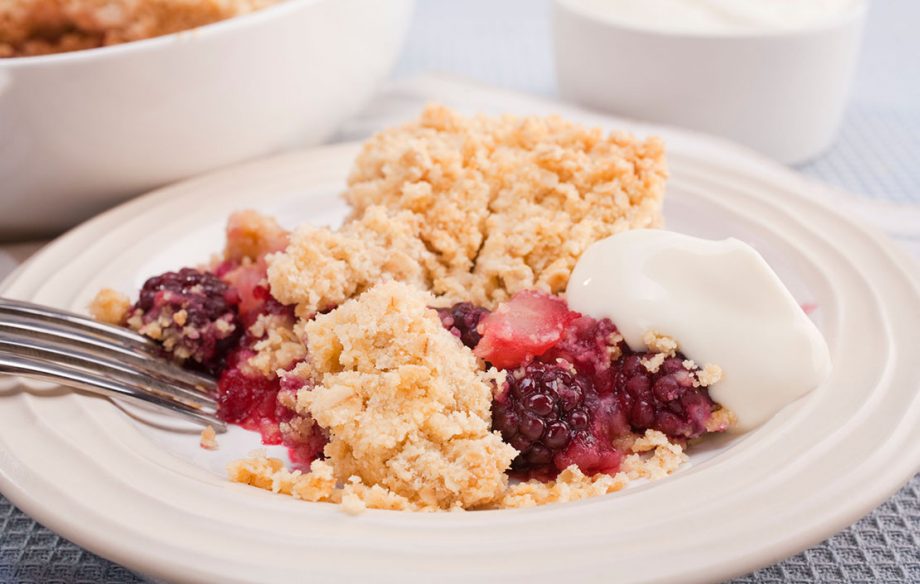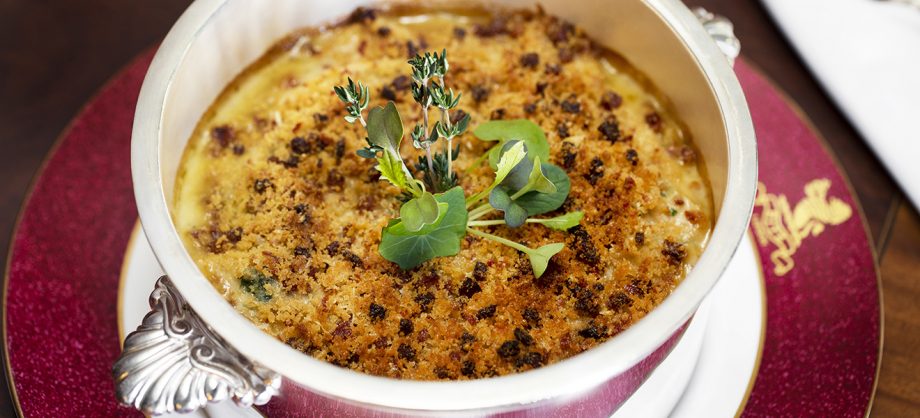
ARTON PROGRAM - The therapeutic power of the group
Creative projects involving group work - general musical performance or group painting, collage, sculpture - are useful in helping to explore and strengthen social...

I couldn’t be more surprised to learn that crumbles are a relatively recent, wartime invention than if you told me Vera Lynn trilled the White Cliffs of Dover into being in 1942. We imagine that the crumble, that most British of puddings, has always been with us.
However, Alan Davidson’s Oxford Companion to Food states: ‘Recipes for crumble do not appear in old books of English recipes, nor is it recorded until the 20th century. Crumble is much quicker and easier to make than pastry and it seems probable that it developed during the Second World War.’

In her fine book English Puddings: Sweet and Savoury, Mary Norwak claimed the first printed mention of the crumble appeared in the 1950 edition of Fannie Farmer’s Boston Cooking School Cook Book – so, both recent and American.
This has shaken me to my foundations and the only remedy I know is to retreat to the kitchen and cook. Mercifully, The National Trust Book of Crumbles by Laura Mason falls onto my kitchen table, filled with comforting recipes for crumbles sweet and savoury, together with their doughy cousins crisps, cobblers, grunts, slumps, buckles, pandowdies and sonkers (such irresistibly sturdy, labradorish names).

The beauty of crumbles is that they have so few ingredients, sometimes as few as four – fruit, flour, butter and sugar – which, with the addition of heat, transform themselves into puddings of sublime comfort.
Crumbles have everything. They’re sweet, tart, yielding, crunchy and caramelised. They are the hometown boyfriends of puddings. Our heads may occasionally be turned by other, more superficially thrilling specimens, but, oh, the joy of coming home.
‘A deconstructed crumble is a tragic thing.
Compote, crumbled biscuits, a dod of cream. Where’s the love?’
It’s hardly surprising that, in the past couple of decades, the revival of interest in English food has meant that the humble crumble has claimed its place on many fashionable menus. Unfortunately, it’s also fallen prey to the insidious modern trend of being ‘deconstructed’, with the crumble baked separately and then scattered over fruit compote, resulting in yielding fruit topped with honeyed rubble and disappointment.
In a brave moment, I asked Jeremy Lee, king of puddings and chef-proprietor at London’s Quo Vadis restaurant, what he thought about this trend. ‘A deconstructed crumble is a tragic thing. Compote, crumbled biscuits, a dod of cream. Where’s the love?’ opines Mr Lee.

‘What could be better than some beautiful, piping-hot rhubarb or apples or gooseberries bubbling away beneath a beautiful crumble? What could possibly be more divinely tempting? All that deliciously gooey goo beneath the crust is absolutely irresistible.’
In her book, Miss Mason gives the portions of the classic crumble as two parts flour and one part each sugar and butter. Fiddling with the proportions and including a higher percentage of sugar and butter gives crisper, less cakey results. Using equal quantities makes it very crisp indeed, creating something that’s perhaps better as a streusel topping for a fruit tart.
‘You want the temperature to be somewhere between
blistering heart-of-the-volcano hot and warm’
You can also experiment with different combinations of sugars, perhaps using some demerara or light muscovado for their textures and toffee-ish notes. Try substituting ground or chopped nuts for some of the flour – up to about 20% almonds, hazelnuts or walnuts works very well. Adding ground ginger, cinnamon, nutmeg or even the barest amount of cardamom or citrus zest to the flour can also elevate this humble pud to its Sunday best. Although crumbles are infinitely variable, I resist the temptation to use wholemeal flour and add all manner of seeds and grains. In the pleasure-averse, this inclination is strong and transforms the topping into something that resembles granola.
The joy of a good crumble is that modest ingredients are transformed into something magnificent, not that expensive ingredients are transformed into something worthy. Apart from anything else, nutrition-by-stealth is an insult to good custard.
I rub my topping together by hand. It’s a quick and pleasurable task, so it hardly seems worth hauling the food processor off the shelf and then having to wash it up, too. Also, with a processor, it’s easy to over-process your ingredients, resulting in a tough crumble. Simply sprinkle your gently cosseted topping over the fruit and resist the toughening urge to pat it down (it’s not a criminal).

Fruit for crumbles generally doesn’t need pre-cooking, although apples benefit from a speedy five-minute poach in the barest splash of water or orange juice to get them going and quinces need to be fully softened before going into the oven. Most berries cook to a soft pulp, so they are better mixed with more robust apples, pears, peaches, nectarines or quinces.
Crumbles are also excellent made with any frozen fruit you may have stashed away, especially those short-seasoned jewels such as gooseberries, blackberries or rhubarb.
For unalloyed joy, it’s imperative to cool your crumble a little before serving it. You want the temperature to be somewhere between blistering heart-of-the-volcano hot and warm. They are enormously forgiving; no ‘serve immediately’ tyranny here. Simply take your crumble out of the oven just before you serve your main course and, by the time you are ready to eat it – unless you’re the most garrulous of families – it should be, as Goldilocks would have said, just right.
Serves 6–8
I like to use a mixture of Bramleys and eating apples – I use Coxes here – for greater depth of perfumed flavour and contrasting textures, but, of course, you can use all Bramley if you prefer. Don’t be tempted to cut the fruit too small; you don’t want it to collapse into fluff.
For the crumble:
220g plain flour
¼tspn of salt
½tspn ground cinnamon or ginger (optional)
150g unsalted butter, very cold, cut into small cubes
80g granulated sugar
40g demerara sugar
1tspn finely grated orange zest
3tbspn fresh orange juice
40g flaked almonds or jumbo oats (optional)
For the fruit:
500g Bramley apples, peeled, cored and roughly chopped
500g eating apples, such as Coxes, peeled cored and roughly chopped
80g–100g caster or granulated sugar, depending on the sweetness of the fruit
3tspn freshly squeezed orange juice
1tbspn finely grated orange zest
A splash of water
To serve:
Custard, double cream, crème fraîche or ice cream
Preheat your oven to 180?C/350?F/gas mark 4.
First, make the crumble. In a bowl, whisk together the flour, salt and cinnamon or ginger, if you’re using them. With your fingers, rub in the butter until it resembles coarse crumbs. Stir in the sugars and orange zest with a fork, then trickle on the orange juice and rake through with the fork to form some soft clumps in among the crumble. Put the crumble in the fridge to chill as you prepare the fruit.
Place the fruit in a pan with the sugar, orange juice, zest and a splash of water – just enough to cover the bottom of the pan. Bring to a simmer, cover and cook for about 5 minutes. Tip the fruit into a 2-litre (3½ pint) ovenproof dish and cool slightly.
Scatter the crumble over. You may not need it all, depending on the diameter of your dish – a 1.5cm (half an inch) deep covering will do. (Any leftovers can be frozen for up to two months. Simply sprinkle it over any prepared fruit and bake from frozen, allowing a little extra time for it to become golden.)
Sprinkle on the almonds or oats, if you’re using them. Place on a baking sheet (the fruit can erupt cheerfully through the topping, which you want, but then drip onto the floor of the oven, which you don’t) and bake for 45–55 minutes, until the fruit is bubbling and the crumble is golden and crunchy on top. Cool slightly before serving.

Creative projects involving group work - general musical performance or group painting, collage, sculpture - are useful in helping to explore and strengthen social...

In the ARTON Program our team of oncopsychologists, art therapists and music therapists develops the process of children's creativity as a process of...

In ARTON sessions, creating a piece of music or a song is an emotional experience of coping and satisfaction for the participating children. They make friends with...

Painting provides patients with a spontaneous, plastic method of depicting thoughts and experiences. Painting with paints is not as structured as with pencil or...










